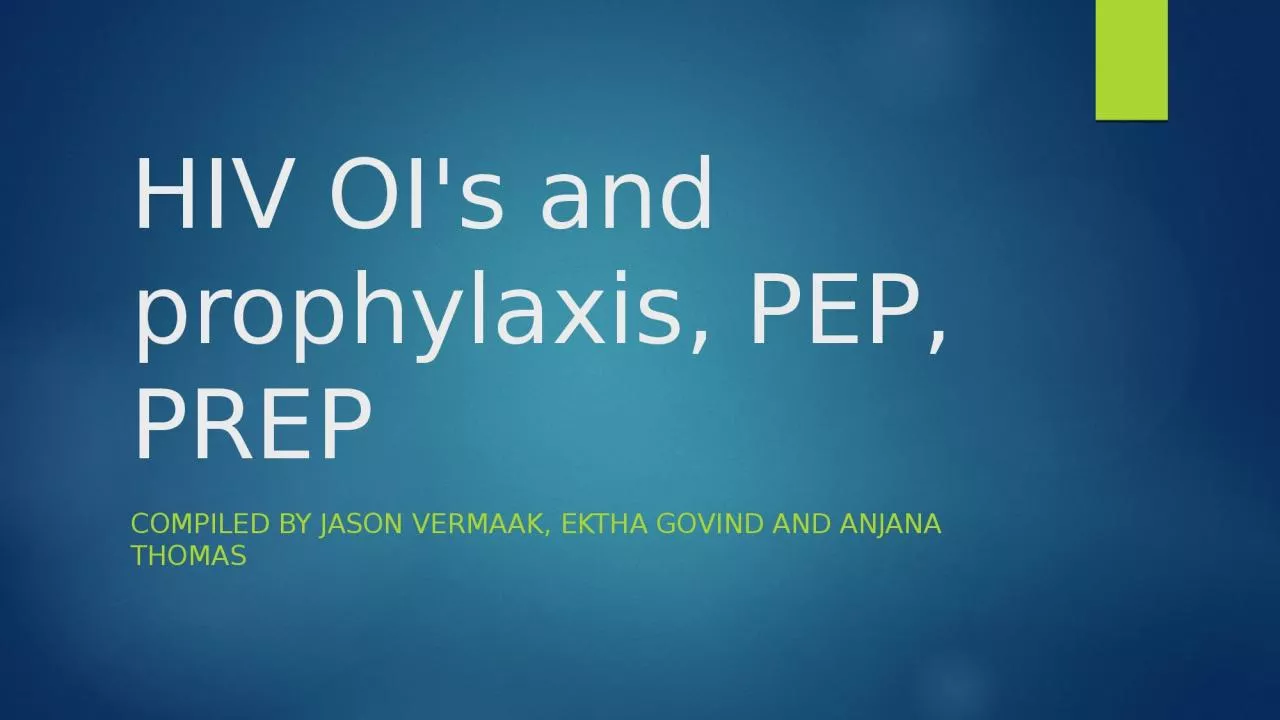

PEP PREP Compiled by Jason Vermaak Ektha govind and Anjana Thomas Opportunistic infection In HIV Opportunistic infections are those that occur more frequently in immunocompromised populations and are often more clinically severe in this group of people ID: 1042211
Download Presentation The PPT/PDF document "HIV OI's and prophylaxis" is the property of its rightful owner. Permission is granted to download and print the materials on this web site for personal, non-commercial use only, and to display it on your personal computer provided you do not modify the materials and that you retain all copyright notices contained in the materials. By downloading content from our website, you accept the terms of this agreement.
1. HIV OI's and prophylaxis, PEP, PREP Compiled by Jason Vermaak, Ektha govind and Anjana Thomas
2. Opportunistic infection In HIVOpportunistic infections are those that occur more frequently in immunocompromised populations and are often more clinically severe in this group of people.There is a correlation with CD4 count, hence prophylaxis is mainly offered to individuals with CD4 less than 200.Opportunistic infections is often considered as AIDS- defining illnesses.
3. Opportunistic infections Cryptococcal meningitisToxoplasmosisPCP Oesophageal candidiasisCertain cancers, including Kaposi’s sarcoma, Lymphomas and cervicalCryptosporidiosisCystoisosporiasisCytomegalovirusHerpes simplex virusHistoplasmosisTuberculosis Mycobacterium avium complexProgressive multifocal leukoencephalopathyToxoplasmosisAnd so on. . .
4. Why consider prophylaxis?Morbidity and mortality of these opportunistic infections are severeOI’s accelerate the progression of disease by causing further damage to the body and the complications can be long termUlcerative lesions can facilitate spread of HIV
5. TB prophylaxis All HIV patients irrespective of CD4 countExclusions: Suspected or confirmed TBPeripheral neuropathyLiver diseaseAlcohol abuser Previous MDR or XDR TBINH 300mg dly for 12 months + pyridoxine 25mg dlyPregnant women CD4 more than 350, defer prophylaxis until after deliveryCD4 less than 350, initiate prophylaxis
6. Clo-trimazoleProphylactic against many infections such as: PCP, Toxoplasmosis and cystoisosporiasisIndications: WHO clinical stage 2,3 or 4 CD4 less than 200After 1 year, if CD4 more than 200 then stop this prophylaxisClotrimazole 160/800mg po dly
7. FluconazoleUsed for cryptococcal meningitis NHLS labs automatically do a CrAg test if CD4 is less than 100If CrAg positive and no symptoms of meningitis: Treat with fluconazole 1200mg dly 14 days, then 800mg dly for 8 weeks, then 200mg dly for at least 1 year.After 1 year if CD4 is more than 200 treatment can be stopped.In resource limited setting (No CrAg test):Fluconazole prophylaxis 200mg po dly until CD4 more than 200.
8. Pre exposure prophylaxis (PrEP)PrEP is the use of anti retrovirals by HIV negative individuals before potential exposure to HIV to prevent them from acquiring HIVCriteria to initiate PrEPHIV negative Risk of HIV infectionWilling and able to adhere to PrEPPrepared to repeat RVD testing every 3 monthsNo contra-indications to tenofovir or emtricitabine
9. PrEP cont. . .Contra-indications HIV positive Creatinine clearance less than 60Use of other nephrotoxic agentsYoung individuals less than 35kgs or less than 15 years of age who are less than Tanner stage 4 Tests required before initiation HIV testCreatinineHep B surface antigenPregnancy test
10. PrEP cont. . .Regimen:Tenofovir 300mg dlyEmtricitabine 200mg dly
11. Post-Exposure Prophylaxis (PEP)Occupational exposure and HPCSA guidelinesIncreased risk of transmission in health care workersTransmission through infected blood or other bodily fluidsRisk reduced through effective IPC measuresHPCSA guidelinesPEP must be available where increased risk for transmission is present All healthcare institutions must have clear and concise policy on PEPStudents at risk should be insured either by university or training siteUniversal precautions should be followed and correct tools supplied by the institution
12. PEP cont. . .Assess risk IndicatedDeep percutaneous sharp injuries Percutaneous exposure involving hollow needle used in vein or arteryVisible blood on sharp instrument involved in percutaneous injurySource patient has terminal disease or with high viral loadContact of bodily fluid (exclude urine, saliva and sweat) and blood with non intact skin or mucous membranes (in particular conjunctiva)Not indicatedThe material exposed to the health care worker not infectious for HIV Patient not infected and no features of seroconversionHealth care worker positive
13. PEP cont. . .Baseline testFBCU/E (creat)HEP studies: Heb B Surface AB, HCV AB Syphillis serologyHIV rapid
14. PEP cont. . .Regimen (all for 4 weeks)Tenofovir 300mg dly (provided eGFR more than 50)Lamividine 200mg dly Dolutegravir 50mg dly In women of childbearing age, pregnant women (less than 6 weeks) or if dolutegravir not tolerated:Tenofovir 300mg dlyEmitricitabine 200mg dly Atazanivir/Ritonavir 300/100mg dly OR Lopinavir/ritonavir 200/50mg 2 tabs bdIf Tenofovir contraindicated or patient failing Tenofovir regimen replace Tenofovir and emtricitabine with zidovudine 300mg bd and lamivudine 150mg bdIf source patient is failing ART regimen adjust PEP
15. PEP cont. . .Follow-up2 weeks If tenofovir is part of PEP then check creatinine If AZT is part of PEP then check FBC6 weeksHCV PCRHIV ELISA4 months HIV ELISA
16. ReferencesStandard Treatment Guidelines and Essential Medicines List for South Africa, Hospital Level, Adults 2019 Editionfile:///C:/Users/ThinkPad%20X280/Desktop/PrEP%20Guidelines%20Final%2020%20Aug%202019.pdfhttps://www.hpcsa.co.za/Uploads/Professional_Practice/Ethics_Booklet.pdfhttps://www.hpcsa-blogs.co.za/wp-content/uploads/2017/04/2017-IN-Handbook-ANNEXURE-H.pdf